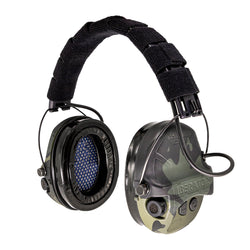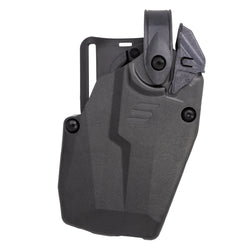Used by countless city, state, and federal law enforcement agencies and carried by millions of civilians nationwide, the Glock 17 pistol needs no introduction. With the recent launch of the Gen 6 G17, the workhorse legacy has been updated for the modern shooter, but its core dependability remains the standard.
It’s become a household name. Even if you’ve never shot before, you’ve probably heard of it. But I’d be willing to bet that you’ve owned one or, at the very least, handled one before. It’s awfully hard to imagine anyone asking what is a Glock 17?

Even in a market dominated by micro-compacts and the resurgence of 6-shooters, the Glock 17 stands out. Not because of some flashy design, timeless folklore, or Hollywood spectre. Instead, I’d argue it’s the exact opposite. It’s the no-nonsense, purpose-built design that keeps us coming back to it, time and time again.
It’s reliable when it counts, easy to operate, and built to withstand the kind of abuse that would render other pistols ineffective. It might not win any awards for its aesthetics, but there’s little doubt that it’ll still be running long after prettier guns have choked.
But don’t just take my word at face value. Instead, let’s dig into what makes the Glock 17 such a duty workhorse and how it’s earned its international acclaim.
America’s Duty Gun
When Gaston Glock introduced the Glock 17 in the early 1980s, few could’ve predicted the seismic shift it would cause in the handgun world. After all, it was a “cheap plastic” gun in a market that was, at the time, dominated by steel-framed guns and revolvers.
But fast forward to today, and the Glock 17 has become one of the most widely issued sidearms in law enforcement history.
Why, though? Why, out of all the quality sidearms out there, did the G17 land as one of the most popular guns in modern history? Well, I think there are a few reasons.
Becoming An Icon
For one, it’s absurdly reliable. Glock pistols have earned a near-mythical reputation for functioning reliably in the dirtiest and dingiest environments and running through hundreds, no thousands, of rounds without so much as a drop of oil or single swab of a bore brush.
And I say “near-mythical” because I’ve yet to see the claim debunked.
Not that I’d condone such treatment of your sidearm, but in my experience, the Glock 17 just runs. Wet, dry, dirty, or caked with mud – it doesn’t matter; the Glock is gonna keep running strong.
This is precisely the kind of durability that matters to law enforcement officers, whose gear may be subjected to brutal conditions and extreme environmental factors on any given shift.

Another reason is simplicity. The Glock 17 doesn’t have an external safety lever to fiddle with, and its internal Safe Action System makes it fast and straightforward to deploy under stress. No fumbling with stiff grip safeties or actuating cumbersome safety levers. And, fewer moving parts means fewer things to break or fail. It doesn’t get much better than that.
Weight and capacity also play a huge role. The Glock 17’s polymer frame keeps it lightweight for all-day carry, and with a standard 17-round magazine, it offers plenty of firepower without being overly bulky. Compare that to older service pistols like the 1911 or full-size, duty revolvers, and it’s easy to see the appeal.
Don’t get me wrong, I love me a classic 1911 or Beretta M9, but there’s a pretty noticeable weight difference there.
And finally, the Glock 17 has become something of a cultural icon. You’ve likely seen it on gun shirts, in movies, on TV shows, in video games, and all sorts of media. It’s easily recognizable, and even politicians (on both sides of the aisle) are familiar with the Glock 17, which has kinda solidified its place in the public’s mind as America’s duty gun.
What is a Glock 17?
While the Glock 17 has gone through several generations since its debut, including the newer Gen 5 models, the Gen 4 version holds a special place for a lot of shooters. Myself included.
In fact, I spotted a like-new, lightly used Gen 4 Glock 17 for about $350 and had to add it to my collection. After all, at that price, I’d be stupid to pass it up, right? My wife might disagree…

A refined design
Anyway, the Gen 4 Glock 17 refined the original design while sticking to what worked. It maintained the iconic, cookie-cutter square slide profile of the earlier generations. It also kept the traditional Glock “U” sight design. But it broke away from those earlier designs by adding interchangeable backstraps and more pronounced finger grooves.
Some folks complain about the finger grooves, which were done away with with Gen 5 models, but with my larger hands and sausage fingers, I’m rather fond of them.
The Gen 4 also brought about the introduction of a dual recoil spring assembly design, which drastically reduces felt recoil and extends the pistol’s lifespan. In practice, it makes shooting the Glock 17 a bit smoother, especially during rapid-fire strings. It’s not a game-changing, world-shattering improvement, but it’s one of those tweaks you appreciate after a long day at the range.

Texture-wise, the Gen 4 frame ditched the smooth grip of earlier models for a more aggressive, stippled surface. It’s grippy without being uncomfortable, which is nice when working in wet conditions or while wearing gloves.
However, I will say that the Gen 4 stippling seems to bite just a bit harsher than the Gen 5 pattern. It digs into your palm more aggressively than Gen 3 and Gen 5 models, but I kinda like that for a duty gun.
Easy to customize
But as many would likely agree, the biggest selling point of the G17 is its customizability. Aftermarket parts are everywhere. You can swap triggers, sights, magazine releases, slide plates, and even entire slide assemblies if you so choose. That’s not my jam, but to each their own. (Of course, with the Gen 6 now offering a factory flat trigger and a superior Optics Ready System, some of those essential aftermarket upgrades may become obsolete.)
Some shooters like to turn their factory Glocks into custom rigs with optics-ready slides or threaded barrels for suppressors. Others keep it bone-stock and just upgrade the sights. Either way, the options are nearly endless.

That said, though, if there’s one complaint you’ll hear about factory Glocks, it’s the stock plastic sights. They get the job done, but they’re nothing to write home about. Luckily, replacing them with steel irons or night sights is easy and relatively cheap. Again, the options are fairly limitless.
At the end of the day, though, the Glock 17 — no matter what generation — is easily one of my favorite striker-fired handguns, especially for home defense. And many of my LEO friends attest to its reliability as their standard-issue duty sidearm. It’s not an overly sexy gun. But it’s also not not sexy, either, and it’s all too easy to make it your own.
The Glock 17 at the range
To see how the Glock 17 holds up in the real world, I took it to the range with 800 rounds of Federal American Eagle 9mm FMJ ammo and 150 rounds of Federal Punch Personal Defense ammo, generously supplied by the folks over at Ammo To Go. The plan was simple: shoot the gun a lot, get ‘er nice and dirty, and see how it handled high round counts with different loads and bullet types.

As one would expect, it was reliable and consistent. Boringly so.
No malfunctions, no hiccups, no fuss. I ran through rapid-fire drills, mag dumps, slow and precise groups at 25 yards, and even some weak-hand-only shooting (I’m terrible with my left hand).
Right out of the box, the Glock 17 feels familiar. The grip angle is classic Glock, the trigger has that slightly spongy wall followed by a clean break, and the reset is snappy and audible. It might not be the most refined trigger on the market, but it’s consistent, and consistency matters when you’re putting round after round downrange.
Reliable accuracy
Accuracy-wise, it’s what you’d expect from a duty pistol. At defensive distances, it’s practically boring how reliably it hits center mass.
At 25 yards, with stock sights and ammo ranging from run-of-the-mill FMJ ball ammo to premium hollow points, the groups opened up a bit but stayed respectable. It’s not a target pistol, but it more than gets the job done.
By the 800-round mark, my hands were tired and my ammo boxes were empty, but the Glock was still trucking along. No cleaning, no lubrication added mid-session, just a steady diet of 9mm ammo.
What more can I say? The Glock 17 is built to work. And that’s just what it does.
It’s not fancy, and it’s certainly not chasing any trends or breaking barriers. It’s doing what it was designed to do. Honestly, though, I’m here for it. It works and works well. That’s good enough for me.
A few Simple Glock 17 upgrades
The Glock 17 is reliable and effective in its factory configuration. That’s obvious.
However, there are a few simple upgrades that, I think, take the Glock 17 from brick to bull. Of course, it’s a Glock, so the world is your oyster. But to get the most out of the gun without breaking the bank, these are worth a look.
Night Sights
Factory Glock sights get the job done, but they’re not great. They’re plastic, basic, and about as exciting as a dental appointment. One of the first upgrades any Glock 17 owner should consider is a solid set of night sights. Think Trijicon HD XR, AmeriGlo Bold, or even Glock factory night sights.

Not only will they improve your low-light performance, but good night sights also offer a faster, cleaner sight picture in daylight conditions. Plus, they’ll draw your eye more naturally, so you’ll shoot faster, track better, and deliver more accurate shots on target.
Enhanced Trigger
Out of the box, Glock triggers are fine. They’re consistent and safe, but they’re admittedly a little spongy. The Glock 17 pistol is no different.
But installing a quality aftermarket trigger can make all the difference. Drop-in trigger kits can easily clean up the break, reduce pre-travel, and give you a much crisper reset.
Personally, I kinda like the Glock Performance Trigger. It’s a factory part, but it’s a hell of an improvement over the OEM factory trigger. Especially with the Gen 4 model.
The difference is noticeable on your first shot. Better triggers help with accuracy, follow-up speed, and overall confidence behind the gun.
Weapon-Mounted Light
While many would say a light on your gun is voluntary, I’d argue that it’s more of a requirement, especially for duty and home defense guns.
Being able to positively identify what you’re aiming at goes back to the basics of gun safety and responsible gun ownership. Lights like the SureFire X300 and Nightstick TWM-30 are rock-solid options that balance brightness, durability, and intuitive controls.
A good weaponlight keeps you in control of the situation without fumbling for a handheld flashlight, and the added weight up front actually helps tame recoil a little. Honestly, it’s a no-brainer.
Strap up!
The G17 might not be the most exciting pistol in the gun case these days, but that’s kind of the point. It’s built with purpose; a workhorse, rather than a flashy show pony. And in a world where feature-rich designs and tactical buzzwords can sometimes overshadow functionality, the Glock 17 keeps proving that simple designs still matter.
Whether you’re looking for a home-defense pistol, a duty gun, or a dependable range gun, the G17 should absolutely be on your shortlist. Its reputation is well-earned, and even decades after its debut, it’s still one of the best sidearms on the market.
If you’ve never spent time behind the trigger of a Glock 17 pistol — or maybe it’s been a while since you shot one — I’d encourage you to hit up your local range and give it a go. Gen 4 or Gen 5, bone-stock or Gucci’d up, it’s a gun that earns its place in your collection the old-fashioned way: by working when you need it to.
In fact, tracking down a Gen 6 model might be worth the effort, as it delivers the legendary reliability of the G17, only now with the enhanced ergonomics that truly earn the “Perfection” moniker.









